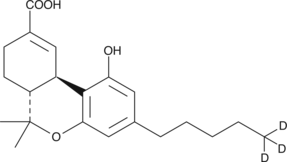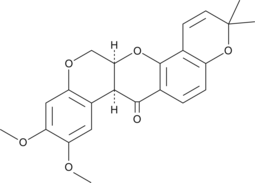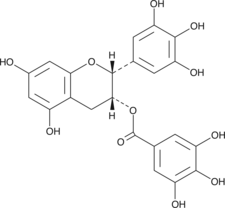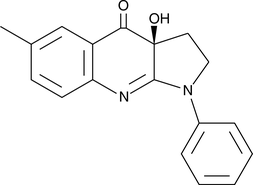Chemicals
Showing 1–150 of 41137 results
-
Cathinone, the main psychoactive alkaloid from the khat plant (C. edulis), is a potent central stimulant and a naturally occurring analog of amphetamine. Cathinone, the main psychoactive alkaloid from the khat plant (C. edulis), is a potent central stimulant and a naturally occurring analog of amphetamine. (−)-(S)-Cathinone is several times more potent than its (+)-isomer, and its absolute stereochemistry is identical to that of (+)-(S)-amphetamine.{20224} Like amphetamine, (−)-(S)-cathinone is a potent releaser of norepinephrine and dopamine from their intracellular stores.{21931,21932} With an ED50 value of 0.42 μmol/kg, (−)-(S)-cathinone produces amphetamine-like stimulus effects in rats trained to discriminate 1 mg/kg of (+)-(S)-amphetamine from vehicle.{20224} This product is intended for research and forensic applications.
Brand:CaymanSKU:-(−)-11-nor-9-carboxy-Δ9-THC-d3 (exempt preparation) contains three deuterium atoms at the 5 position. It is intended for use as an internal standard for the quantification of (−)-11-nor-9-carboxy-Δ9-THC (exempt preparation) by GC- or LC-mass spectrometry. Δ9-Tetrahydrocannabinol (Δ9-THC), the active constituent of marijuana, is metabolized primarily by hydroxylation at the allylic C-11 position followed by oxidation to (−)-11-nor-9-carboxy-Δ9-THC. (−)-11-nor-9-carboxy-Δ9-THC is the major metabolite of Δ9-THC and is used as an internal standard in various analytical procedures to unequivocally confirm its presence in biological fluids.{14785}
Brand:CaymanSKU:10009898 - 1 mgAvailable on backorder
(−)-11-nor-9-carboxy-Δ9-THC-d3 (exempt preparation) contains three deuterium atoms at the 5 position. It is intended for use as an internal standard for the quantification of (−)-11-nor-9-carboxy-Δ9-THC (exempt preparation) by GC- or LC-mass spectrometry. Δ9-Tetrahydrocannabinol (Δ9-THC), the active constituent of marijuana, is metabolized primarily by hydroxylation at the allylic C-11 position followed by oxidation to (−)-11-nor-9-carboxy-Δ9-THC. (−)-11-nor-9-carboxy-Δ9-THC is the major metabolite of Δ9-THC and is used as an internal standard in various analytical procedures to unequivocally confirm its presence in biological fluids.{14785}
Brand:CaymanSKU:10009898 - 100 µgAvailable on backorder
(−)-11-nor-9-carboxy-Δ9-THC-d3 (exempt preparation) contains three deuterium atoms at the 5 position. It is intended for use as an internal standard for the quantification of (−)-11-nor-9-carboxy-Δ9-THC (exempt preparation) by GC- or LC-mass spectrometry. Δ9-Tetrahydrocannabinol (Δ9-THC), the active constituent of marijuana, is metabolized primarily by hydroxylation at the allylic C-11 position followed by oxidation to (−)-11-nor-9-carboxy-Δ9-THC. (−)-11-nor-9-carboxy-Δ9-THC is the major metabolite of Δ9-THC and is used as an internal standard in various analytical procedures to unequivocally confirm its presence in biological fluids.{14785}
Brand:CaymanSKU:10009898 - 500 µgAvailable on backorder
(-)-Altenuene is a natural mycotoxin that was first isolated from A. tenuis. It has antioxidant activity and inhibits cholinesterases.{33240} Unlike tenuazonic acid (Item No. 11443), (-)-altenuene does not display toxicity as assessed by the chicken embryo assay.{20841} (-)-Altenuene does not display significant topoisomerase inhibitory activity, unlike alternariol (Item No. 11306).{33241}
Brand:CaymanSKU:21130 -Out of stock
KIAA1363 is a 2-acetyl monoacylglyceryl ether (MAGE) hydrolase that is upregulated in aggressive cancers from various tissues.{17107} The enzyme catalyzes the hydrolysis of the 2-acetyl MAGE to MAGE and serves as a central enzyme in the PAF and LPA signaling network.{14603} AS 115 is a potent and selective inactivator of KIAA1363, displaying an IC50 value of 150 nM when tested as a racemic mixture in the invasive ovarian cancer cell line SKOV3.{14603} Treatment of SKOV3 cells with 10 µM AS-115 for 4 hours significantly reduced the formation of MAGE, alkyl-lysophosphatidylcholine, and alkyl-lysophosphatidic acid. The activity of the individual enantiomers of AS 115, i.e. (+)-AS 115 and (−)-AS 115, has not been determined.
Brand:CaymanSKU:-KIAA1363 is a 2-acetyl monoacylglyceryl ether (MAGE) hydrolase that is upregulated in aggressive cancers from various tissues.{17107} The enzyme catalyzes the hydrolysis of the 2-acetyl MAGE to MAGE and serves as a central enzyme in the PAF and LPA signaling network.{14603} AS 115 is a potent and selective inactivator of KIAA1363, displaying an IC50 value of 150 nM when tested as a racemic mixture in the invasive ovarian cancer cell line SKOV3.{14603} Treatment of SKOV3 cells with 10 µM AS-115 for 4 hours significantly reduced the formation of MAGE, alkyl-lysophosphatidylcholine, and alkyl-lysophosphatidic acid. The activity of the individual enantiomers of AS 115, i.e. (+)-AS 115 and (−)-AS 115, has not been determined.
Brand:CaymanSKU:-KIAA1363 is a 2-acetyl monoacylglyceryl ether (MAGE) hydrolase that is upregulated in aggressive cancers from various tissues.{17107} The enzyme catalyzes the hydrolysis of the 2-acetyl MAGE to MAGE and serves as a central enzyme in the PAF and LPA signaling network.{14603} AS 115 is a potent and selective inactivator of KIAA1363, displaying an IC50 value of 150 nM when tested as a racemic mixture in the invasive ovarian cancer cell line SKOV3.{14603} Treatment of SKOV3 cells with 10 µM AS-115 for 4 hours significantly reduced the formation of MAGE, alkyl-lysophosphatidylcholine, and alkyl-lysophosphatidic acid. The activity of the individual enantiomers of AS 115, i.e. (+)-AS 115 and (−)-AS 115, has not been determined.
Brand:CaymanSKU:-Cotinine is a minor alkaloid found in tobacco plants and is a major metabolite of nicotine.{20194} It has a long pharmacological half-life (15-19 hours) compared to that of nicotine (2-3 hours) and is often used as a biomarker to detect tobacco use.{24960,20195,20196} Cotinine binds nicotinic- and muscarinic-type acetylcholine receptors with minimal receptor desensitization and demonstrates antipsychotic drug-like properties in behavioral models, neuroprotective properties in neurodegenerative disease models, and enhances attention in a delayed matching-to-sample task.{24960}
Brand:CaymanSKU:-Cotinine is a minor alkaloid found in tobacco plants and is a major metabolite of nicotine.{20194} It has a long pharmacological half-life (15-19 hours) compared to that of nicotine (2-3 hours) and is often used as a biomarker to detect tobacco use.{24960,20195,20196} Cotinine binds nicotinic- and muscarinic-type acetylcholine receptors with minimal receptor desensitization and demonstrates antipsychotic drug-like properties in behavioral models, neuroprotective properties in neurodegenerative disease models, and enhances attention in a delayed matching-to-sample task.{24960}
Brand:CaymanSKU:-Cotinine is a minor alkaloid found in tobacco plants and is a major metabolite of nicotine.{20194} It has a long pharmacological half-life (15-19 hours) compared to that of nicotine (2-3 hours) and is often used as a biomarker to detect tobacco use.{24960,20195,20196} Cotinine binds nicotinic- and muscarinic-type acetylcholine receptors with minimal receptor desensitization and demonstrates antipsychotic drug-like properties in behavioral models, neuroprotective properties in neurodegenerative disease models, and enhances attention in a delayed matching-to-sample task.{24960}
Brand:CaymanSKU:-Cotinine is a minor alkaloid found in tobacco plants and is a major metabolite of nicotine.{20194} It has a long pharmacological half-life (15-19 hours) compared to that of nicotine (2-3 hours) and is often used as a biomarker to detect tobacco use.{24960,20195,20196} Cotinine binds nicotinic- and muscarinic-type acetylcholine receptors with minimal receptor desensitization and demonstrates antipsychotic drug-like properties in behavioral models, neuroprotective properties in neurodegenerative disease models, and enhances attention in a delayed matching-to-sample task.{24960}
Brand:CaymanSKU:-CP 47,497 is a bicyclic cannabinoid analog with potent analgesic activity.{16402} It is comparable or more potent than Δ9-tetrahydrocannabinol in analgesic, motor depressant, anticonvulsant and hypothermic effects in mice, rats, and dogs.{17029} The levorotatory enantiomer, (−)-CP 47,497 avidly binds the CB1 receptor (Ki = 2.1 nM).{17030}
Brand:CaymanSKU:-CP 47,497 is a bicyclic cannabinoid analog with potent analgesic activity.{16402} It is comparable or more potent than Δ9-tetrahydrocannabinol in analgesic, motor depressant, anticonvulsant and hypothermic effects in mice, rats, and dogs.{17029} The levorotatory enantiomer, (−)-CP 47,497 avidly binds the CB1 receptor (Ki = 2.1 nM).{17030}
Brand:CaymanSKU:-CP 47,497 is a bicyclic cannabinoid analog with potent analgesic activity.{16402} It is comparable or more potent than Δ9-tetrahydrocannabinol in analgesic, motor depressant, anticonvulsant and hypothermic effects in mice, rats, and dogs.{17029} The levorotatory enantiomer, (−)-CP 47,497 avidly binds the CB1 receptor (Ki = 2.1 nM).{17030}
Brand:CaymanSKU:-(−)-CP 55,940 is a potent and non-selective cannabinoid (CB) receptor agonist with Ki values of 0.5 to 5 and 0.69 to 2.8 nM for CB1 and CB2 receptors, respectively.{7912} It is more potent than Δ9-THC (Item Nos. 12068 | ISO60157) in both behavioral tests and in receptor binding assays.{14402} In vivo, (−)-CP 55,940 administered intraperitoneally (0.3-3 mg/kg) or as an aerosol (0.72-72 mg/ml), suppresses locomotor activity, increases tail flick latency in a hot plate test for analgesia, and decreases body temperature in mice in a dose-dependent manner.{40291} Subchronic administration of (−)-CP 55,940 (0.03 mg/kg) also reduces body weight loss and running wheel activity in a rat model of anorexia nervosa.{40292}
Brand:CaymanSKU:90084 - 1 mgAvailable on backorder
(−)-CP 55,940 is a potent and non-selective cannabinoid (CB) receptor agonist with Ki values of 0.5 to 5 and 0.69 to 2.8 nM for CB1 and CB2 receptors, respectively.{7912} It is more potent than Δ9-THC (Item Nos. 12068 | ISO60157) in both behavioral tests and in receptor binding assays.{14402} In vivo, (−)-CP 55,940 administered intraperitoneally (0.3-3 mg/kg) or as an aerosol (0.72-72 mg/ml), suppresses locomotor activity, increases tail flick latency in a hot plate test for analgesia, and decreases body temperature in mice in a dose-dependent manner.{40291} Subchronic administration of (−)-CP 55,940 (0.03 mg/kg) also reduces body weight loss and running wheel activity in a rat model of anorexia nervosa.{40292}
Brand:CaymanSKU:90084 - 10 mgAvailable on backorder
(−)-CP 55,940 is a potent and non-selective cannabinoid (CB) receptor agonist with Ki values of 0.5 to 5 and 0.69 to 2.8 nM for CB1 and CB2 receptors, respectively.{7912} It is more potent than Δ9-THC (Item Nos. 12068 | ISO60157) in both behavioral tests and in receptor binding assays.{14402} In vivo, (−)-CP 55,940 administered intraperitoneally (0.3-3 mg/kg) or as an aerosol (0.72-72 mg/ml), suppresses locomotor activity, increases tail flick latency in a hot plate test for analgesia, and decreases body temperature in mice in a dose-dependent manner.{40291} Subchronic administration of (−)-CP 55,940 (0.03 mg/kg) also reduces body weight loss and running wheel activity in a rat model of anorexia nervosa.{40292}
Brand:CaymanSKU:90084 - 25 mgAvailable on backorder
(−)-CP 55,940 is a potent and non-selective cannabinoid (CB) receptor agonist with Ki values of 0.5 to 5 and 0.69 to 2.8 nM for CB1 and CB2 receptors, respectively.{7912} It is more potent than Δ9-THC (Item Nos. 12068 | ISO60157) in both behavioral tests and in receptor binding assays.{14402} In vivo, (−)-CP 55,940 administered intraperitoneally (0.3-3 mg/kg) or as an aerosol (0.72-72 mg/ml), suppresses locomotor activity, increases tail flick latency in a hot plate test for analgesia, and decreases body temperature in mice in a dose-dependent manner.{40291} Subchronic administration of (−)-CP 55,940 (0.03 mg/kg) also reduces body weight loss and running wheel activity in a rat model of anorexia nervosa.{40292}
Brand:CaymanSKU:90084 - 5 mgAvailable on backorder
Rotenoids, deriving from the flavonoid family of compounds, act as chemopreventive agents that inhibit NADH:ubiquinone oxidoreductase activity and suppress phorbol ester-induced ornithine decarboxylase (ODC) activity.{16334} The rotenoid compound deguelin, originally isolated from the bark of M. sericea (Leguminosae) to be used as an insecticide and fish poison, has chemopreventive and chemosensitizing effects in models of skin, mammary, colon, and lung carcinogenesis.{16333,16330,16332} Deguelin inhibits cell growth (IC50 = 8 M), blocks PI3K/Akt activation, suppresses COX-2 expression, and induces apoptosis in premalignant and squamous human bronchial epithelial (HBE) cells without affecting normal HBE cells.{16333,16331} At 6 mg/kg, deguelin induces Parkinson’s disease-like symptoms in rats after six days of subcutaneous infusion and therefore may also serve as a useful model for Parkinson’s disease research.{16314}
Brand:CaymanSKU:10010706 - 10 mgAvailable on backorder
Rotenoids, deriving from the flavonoid family of compounds, act as chemopreventive agents that inhibit NADH:ubiquinone oxidoreductase activity and suppress phorbol ester-induced ornithine decarboxylase (ODC) activity.{16334} The rotenoid compound deguelin, originally isolated from the bark of M. sericea (Leguminosae) to be used as an insecticide and fish poison, has chemopreventive and chemosensitizing effects in models of skin, mammary, colon, and lung carcinogenesis.{16333,16330,16332} Deguelin inhibits cell growth (IC50 = 8 M), blocks PI3K/Akt activation, suppresses COX-2 expression, and induces apoptosis in premalignant and squamous human bronchial epithelial (HBE) cells without affecting normal HBE cells.{16333,16331} At 6 mg/kg, deguelin induces Parkinson’s disease-like symptoms in rats after six days of subcutaneous infusion and therefore may also serve as a useful model for Parkinson’s disease research.{16314}
Brand:CaymanSKU:10010706 - 25 mgAvailable on backorder
Rotenoids, deriving from the flavonoid family of compounds, act as chemopreventive agents that inhibit NADH:ubiquinone oxidoreductase activity and suppress phorbol ester-induced ornithine decarboxylase (ODC) activity.{16334} The rotenoid compound deguelin, originally isolated from the bark of M. sericea (Leguminosae) to be used as an insecticide and fish poison, has chemopreventive and chemosensitizing effects in models of skin, mammary, colon, and lung carcinogenesis.{16333,16330,16332} Deguelin inhibits cell growth (IC50 = 8 M), blocks PI3K/Akt activation, suppresses COX-2 expression, and induces apoptosis in premalignant and squamous human bronchial epithelial (HBE) cells without affecting normal HBE cells.{16333,16331} At 6 mg/kg, deguelin induces Parkinson’s disease-like symptoms in rats after six days of subcutaneous infusion and therefore may also serve as a useful model for Parkinson’s disease research.{16314}
Brand:CaymanSKU:10010706 - 5 mgAvailable on backorder
Rotenoids, deriving from the flavonoid family of compounds, act as chemopreventive agents that inhibit NADH:ubiquinone oxidoreductase activity and suppress phorbol ester-induced ornithine decarboxylase (ODC) activity.{16334} The rotenoid compound deguelin, originally isolated from the bark of M. sericea (Leguminosae) to be used as an insecticide and fish poison, has chemopreventive and chemosensitizing effects in models of skin, mammary, colon, and lung carcinogenesis.{16333,16330,16332} Deguelin inhibits cell growth (IC50 = 8 M), blocks PI3K/Akt activation, suppresses COX-2 expression, and induces apoptosis in premalignant and squamous human bronchial epithelial (HBE) cells without affecting normal HBE cells.{16333,16331} At 6 mg/kg, deguelin induces Parkinson’s disease-like symptoms in rats after six days of subcutaneous infusion and therefore may also serve as a useful model for Parkinson’s disease research.{16314}
Brand:CaymanSKU:10010706 - 50 mgAvailable on backorder
Catechin is a polyphenolic flavonoid that has been isolated from a variety of natural sources including tea leaves, grape seeds, and the wood and bark of trees such as acacia and mahogany.{7686,23117} Catechin is a more potent antioxidant than ascorbate or α-tocopherol in certain in vitro lipid peroxidation assays.{7582} (−)-Epicatechin is a 2R,3R stereoisomer of catechin. Like catechin, (−)-epicatechin is a powerful antioxidant.{23115} It inhibits cyclooxygenase 1 (IC50 = 3.2 μM).{15205} Also, at 100 µM, (−)-epicatechin induces apoptosis in human adenocarcinoma PC-9 cells and stimulates the inhibition of tumor necrosis factor-α release from BALB-c/3T3 cells treated with epigallocatechin gallate.{23116}
Brand:CaymanSKU:11807 - 1 mgAvailable on backorder
Catechin is a polyphenolic flavonoid that has been isolated from a variety of natural sources including tea leaves, grape seeds, and the wood and bark of trees such as acacia and mahogany.{7686,23117} Catechin is a more potent antioxidant than ascorbate or α-tocopherol in certain in vitro lipid peroxidation assays.{7582} (−)-Epicatechin is a 2R,3R stereoisomer of catechin. Like catechin, (−)-epicatechin is a powerful antioxidant.{23115} It inhibits cyclooxygenase 1 (IC50 = 3.2 μM).{15205} Also, at 100 µM, (−)-epicatechin induces apoptosis in human adenocarcinoma PC-9 cells and stimulates the inhibition of tumor necrosis factor-α release from BALB-c/3T3 cells treated with epigallocatechin gallate.{23116}
Brand:CaymanSKU:11807 - 10 mgAvailable on backorder
Catechin is a polyphenolic flavonoid that has been isolated from a variety of natural sources including tea leaves, grape seeds, and the wood and bark of trees such as acacia and mahogany.{7686,23117} Catechin is a more potent antioxidant than ascorbate or α-tocopherol in certain in vitro lipid peroxidation assays.{7582} (−)-Epicatechin is a 2R,3R stereoisomer of catechin. Like catechin, (−)-epicatechin is a powerful antioxidant.{23115} It inhibits cyclooxygenase 1 (IC50 = 3.2 μM).{15205} Also, at 100 µM, (−)-epicatechin induces apoptosis in human adenocarcinoma PC-9 cells and stimulates the inhibition of tumor necrosis factor-α release from BALB-c/3T3 cells treated with epigallocatechin gallate.{23116}
Brand:CaymanSKU:11807 - 25 mgAvailable on backorder
Catechin is a polyphenolic flavonoid that has been isolated from a variety of natural sources including tea leaves, grape seeds, and the wood and bark of trees such as acacia and mahogany.{7686,23117} Catechin is a more potent antioxidant than ascorbate or α-tocopherol in certain in vitro lipid peroxidation assays.{7582} (−)-Epicatechin is a 2R,3R stereoisomer of catechin. Like catechin, (−)-epicatechin is a powerful antioxidant.{23115} It inhibits cyclooxygenase 1 (IC50 = 3.2 μM).{15205} Also, at 100 µM, (−)-epicatechin induces apoptosis in human adenocarcinoma PC-9 cells and stimulates the inhibition of tumor necrosis factor-α release from BALB-c/3T3 cells treated with epigallocatechin gallate.{23116}
Brand:CaymanSKU:11807 - 5 mgAvailable on backorder
The catechins, including (−)-epicatechin (EC) and (−)-epigallocatechin gallate (EGCG) (Item No. 70935), are polyphenols which are abundant in green and black teas. (−)-Epicatechin gallate (ECG) is a natural catechin with a single galloyl group. Like EGCG, it inhibits the growth of cancer cells and has anti-inflammatory effects.{23119,23117,23118} The hydroxyl groups of ECG contribute to its potent antioxidant activity and facilitate the killing of methicillin-resistant strains of S. aureus.{23115,23120}
Brand:CaymanSKU:11808 - 1 mgAvailable on backorder
The catechins, including (−)-epicatechin (EC) and (−)-epigallocatechin gallate (EGCG) (Item No. 70935), are polyphenols which are abundant in green and black teas. (−)-Epicatechin gallate (ECG) is a natural catechin with a single galloyl group. Like EGCG, it inhibits the growth of cancer cells and has anti-inflammatory effects.{23119,23117,23118} The hydroxyl groups of ECG contribute to its potent antioxidant activity and facilitate the killing of methicillin-resistant strains of S. aureus.{23115,23120}
Brand:CaymanSKU:11808 - 10 mgAvailable on backorder
The catechins, including (−)-epicatechin (EC) and (−)-epigallocatechin gallate (EGCG) (Item No. 70935), are polyphenols which are abundant in green and black teas. (−)-Epicatechin gallate (ECG) is a natural catechin with a single galloyl group. Like EGCG, it inhibits the growth of cancer cells and has anti-inflammatory effects.{23119,23117,23118} The hydroxyl groups of ECG contribute to its potent antioxidant activity and facilitate the killing of methicillin-resistant strains of S. aureus.{23115,23120}
Brand:CaymanSKU:11808 - 25 mgAvailable on backorder
The catechins, including (−)-epicatechin (EC) and (−)-epigallocatechin gallate (EGCG) (Item No. 70935), are polyphenols which are abundant in green and black teas. (−)-Epicatechin gallate (ECG) is a natural catechin with a single galloyl group. Like EGCG, it inhibits the growth of cancer cells and has anti-inflammatory effects.{23119,23117,23118} The hydroxyl groups of ECG contribute to its potent antioxidant activity and facilitate the killing of methicillin-resistant strains of S. aureus.{23115,23120}
Brand:CaymanSKU:11808 - 5 mgAvailable on backorder
(−)-Epigallocatechin ((−)-EGC) is a major green tea polyphenol with antioxidant, anti-inflammatory, and anticancer activities. It has been shown to scavenge DPPH radicals with an EC50 value of 0.01 mM and to prevent the growth of several different AML cell lines at micromolar concentrations.{23115,25720,25718} Furthermore, at 30 µM (−)-EGC can inhibit heregulin-β1-induced migration/invasion of MCF-7 human breast cancer cells.{25719}
Brand:CaymanSKU:11809 - 1 mgAvailable on backorder
(−)-Epigallocatechin ((−)-EGC) is a major green tea polyphenol with antioxidant, anti-inflammatory, and anticancer activities. It has been shown to scavenge DPPH radicals with an EC50 value of 0.01 mM and to prevent the growth of several different AML cell lines at micromolar concentrations.{23115,25720,25718} Furthermore, at 30 µM (−)-EGC can inhibit heregulin-β1-induced migration/invasion of MCF-7 human breast cancer cells.{25719}
Brand:CaymanSKU:11809 - 10 mgAvailable on backorder
(−)-Epigallocatechin ((−)-EGC) is a major green tea polyphenol with antioxidant, anti-inflammatory, and anticancer activities. It has been shown to scavenge DPPH radicals with an EC50 value of 0.01 mM and to prevent the growth of several different AML cell lines at micromolar concentrations.{23115,25720,25718} Furthermore, at 30 µM (−)-EGC can inhibit heregulin-β1-induced migration/invasion of MCF-7 human breast cancer cells.{25719}
Brand:CaymanSKU:11809 - 25 mgAvailable on backorder
(−)-Epigallocatechin ((−)-EGC) is a major green tea polyphenol with antioxidant, anti-inflammatory, and anticancer activities. It has been shown to scavenge DPPH radicals with an EC50 value of 0.01 mM and to prevent the growth of several different AML cell lines at micromolar concentrations.{23115,25720,25718} Furthermore, at 30 µM (−)-EGC can inhibit heregulin-β1-induced migration/invasion of MCF-7 human breast cancer cells.{25719}
Brand:CaymanSKU:11809 - 5 mgAvailable on backorder
(–)-Epigallocatechin gallate (EGCG) is a phenol that has been found in green and black tea plants and has diverse biological activities.{41816,3193,7634,15553,25719,15552,55280} It is lytic against T. cruzi amastigotes, with a 50% bactericidal concentration (MBC50) value of 0.53 pM.{41816} EGCG decreases deoxyguanosine oxidation and tyrosine nitration (IC50s = 0.25 and 0.11 mM, respectively) and inhibits macrophage-mediated LDL oxidation in vitro.{3193,7634} EGCG increases LDL receptor binding activity and lowers cholesterol levels in HepG2 cells via increased cholesterol efflux.{15553} It inhibits heregulin-β1-induced activation of ErbB2 and ErbB3, as well as migration and invasion of MCF-7 breast cancer cells.{25719} In vivo, EGCG reduces food intake and body weight, serum levels of insulin, leptin, testosterone, and growth hormone, and the size of the ventral prostate, testis, liver, and spleen in male Sprague Dawley, lean Zucker, and obese Zucker rats when administered at doses of 82, 81, and 92 mg/kg, respectively.{15552} It also reduces increases in hepatic steatosis, inflammatory cell infiltration, and injury in a mouse model of non-alcoholic steatohepatitis (NASH) induced by a methionine- and choline-deficient diet when administered at doses of 50 and 100 mg/kg.{55280}
Brand:CaymanSKU:70935 - 100 mgAvailable on backorder
(–)-Epigallocatechin gallate (EGCG) is a phenol that has been found in green and black tea plants and has diverse biological activities.{41816,3193,7634,15553,25719,15552,55280} It is lytic against T. cruzi amastigotes, with a 50% bactericidal concentration (MBC50) value of 0.53 pM.{41816} EGCG decreases deoxyguanosine oxidation and tyrosine nitration (IC50s = 0.25 and 0.11 mM, respectively) and inhibits macrophage-mediated LDL oxidation in vitro.{3193,7634} EGCG increases LDL receptor binding activity and lowers cholesterol levels in HepG2 cells via increased cholesterol efflux.{15553} It inhibits heregulin-β1-induced activation of ErbB2 and ErbB3, as well as migration and invasion of MCF-7 breast cancer cells.{25719} In vivo, EGCG reduces food intake and body weight, serum levels of insulin, leptin, testosterone, and growth hormone, and the size of the ventral prostate, testis, liver, and spleen in male Sprague Dawley, lean Zucker, and obese Zucker rats when administered at doses of 82, 81, and 92 mg/kg, respectively.{15552} It also reduces increases in hepatic steatosis, inflammatory cell infiltration, and injury in a mouse model of non-alcoholic steatohepatitis (NASH) induced by a methionine- and choline-deficient diet when administered at doses of 50 and 100 mg/kg.{55280}
Brand:CaymanSKU:70935 - 250 mgAvailable on backorder
(–)-Epigallocatechin gallate (EGCG) is a phenol that has been found in green and black tea plants and has diverse biological activities.{41816,3193,7634,15553,25719,15552,55280} It is lytic against T. cruzi amastigotes, with a 50% bactericidal concentration (MBC50) value of 0.53 pM.{41816} EGCG decreases deoxyguanosine oxidation and tyrosine nitration (IC50s = 0.25 and 0.11 mM, respectively) and inhibits macrophage-mediated LDL oxidation in vitro.{3193,7634} EGCG increases LDL receptor binding activity and lowers cholesterol levels in HepG2 cells via increased cholesterol efflux.{15553} It inhibits heregulin-β1-induced activation of ErbB2 and ErbB3, as well as migration and invasion of MCF-7 breast cancer cells.{25719} In vivo, EGCG reduces food intake and body weight, serum levels of insulin, leptin, testosterone, and growth hormone, and the size of the ventral prostate, testis, liver, and spleen in male Sprague Dawley, lean Zucker, and obese Zucker rats when administered at doses of 82, 81, and 92 mg/kg, respectively.{15552} It also reduces increases in hepatic steatosis, inflammatory cell infiltration, and injury in a mouse model of non-alcoholic steatohepatitis (NASH) induced by a methionine- and choline-deficient diet when administered at doses of 50 and 100 mg/kg.{55280}
Brand:CaymanSKU:70935 - 50 mgAvailable on backorder
(–)-Epigallocatechin gallate (EGCG) is a phenol that has been found in green and black tea plants and has diverse biological activities.{41816,3193,7634,15553,25719,15552,55280} It is lytic against T. cruzi amastigotes, with a 50% bactericidal concentration (MBC50) value of 0.53 pM.{41816} EGCG decreases deoxyguanosine oxidation and tyrosine nitration (IC50s = 0.25 and 0.11 mM, respectively) and inhibits macrophage-mediated LDL oxidation in vitro.{3193,7634} EGCG increases LDL receptor binding activity and lowers cholesterol levels in HepG2 cells via increased cholesterol efflux.{15553} It inhibits heregulin-β1-induced activation of ErbB2 and ErbB3, as well as migration and invasion of MCF-7 breast cancer cells.{25719} In vivo, EGCG reduces food intake and body weight, serum levels of insulin, leptin, testosterone, and growth hormone, and the size of the ventral prostate, testis, liver, and spleen in male Sprague Dawley, lean Zucker, and obese Zucker rats when administered at doses of 82, 81, and 92 mg/kg, respectively.{15552} It also reduces increases in hepatic steatosis, inflammatory cell infiltration, and injury in a mouse model of non-alcoholic steatohepatitis (NASH) induced by a methionine- and choline-deficient diet when administered at doses of 50 and 100 mg/kg.{55280}
Brand:CaymanSKU:70935 - 500 mgAvailable on backorder
(-)-Epinephrine is a natural neurotransmitter that is released from the adrenal medulla and activates adrenoceptors (Kis = 15, 735, and 3,970 nM for α1A-, β2-, and β1-adrenergic receptors, respectively).{26355,25395,30131} Through these receptors, (-)-epinephrine may induce either contraction or relaxation of vascular smooth muscle, depending on adrenoceptor subtype expression.{30131} Receptor-mediated actions of (-)-epinephrine are also relevant to blocking anaphylaxis, reversing cardiac arrest, and reducing bleeding in clinical trials.{30133,30132,30134}
Brand:CaymanSKU:-Available on backorder
(-)-Epinephrine is a natural neurotransmitter that is released from the adrenal medulla and activates adrenoceptors (Kis = 15, 735, and 3,970 nM for α1A-, β2-, and β1-adrenergic receptors, respectively).{26355,25395,30131} Through these receptors, (-)-epinephrine may induce either contraction or relaxation of vascular smooth muscle, depending on adrenoceptor subtype expression.{30131} Receptor-mediated actions of (-)-epinephrine are also relevant to blocking anaphylaxis, reversing cardiac arrest, and reducing bleeding in clinical trials.{30133,30132,30134}
Brand:CaymanSKU:-Available on backorder
(-)-Epinephrine is a natural neurotransmitter that is released from the adrenal medulla and activates adrenoceptors (Kis = 15, 735, and 3,970 nM for α1A-, β2-, and β1-adrenergic receptors, respectively).{26355,25395,30131} Through these receptors, (-)-epinephrine may induce either contraction or relaxation of vascular smooth muscle, depending on adrenoceptor subtype expression.{30131} Receptor-mediated actions of (-)-epinephrine are also relevant to blocking anaphylaxis, reversing cardiac arrest, and reducing bleeding in clinical trials.{30133,30132,30134}
Brand:CaymanSKU:-Available on backorder
(−)-Indolactam V is a tumor-promoting teleocidin compound that activates protein kinase C (PKC). It binds to PKC regulatory domains of mouse skin PKCη and rat brain PKCγ with Ki values of 3.4 nM and 1 μM, respectively.{23150,23151} At 1 μM, (−)-indolactam V induces differentiation of human embryonic stem cells into pancreatic progenitors through activation of PKC signaling.{23152}
Brand:CaymanSKU:-(−)-Indolactam V is a tumor-promoting teleocidin compound that activates protein kinase C (PKC). It binds to PKC regulatory domains of mouse skin PKCη and rat brain PKCγ with Ki values of 3.4 nM and 1 μM, respectively.{23150,23151} At 1 μM, (−)-indolactam V induces differentiation of human embryonic stem cells into pancreatic progenitors through activation of PKC signaling.{23152}
Brand:CaymanSKU:-S-Adenosylhomocysteine (SAH) hydrolase catalyzes the reversible hydrolysis of SAH to adenosine and homocysteine. The inhibition of SAH hydrolase causes the intracellular accumulation of SAH, elevating the ratio of SAH to S-adenosylmethionine (SAM) and inhibiting SAM-dependent methyltransferase. (−)-Neplanocin A potently and irreversibly inactivates SAH hydrolase (Ki = 8.39 nM).{18488} It has antitumor activity against mouse leukemia L1210 cells and broad-spectrum antiviral activity.{19250,19251,19249,18488} Neplanocin A is more potent against vesicular stomatitis than the reversible SAH hydrolase inhibitor 3-deazaneplanocin (ID50 = 0.07 and 0.3 μg/ml, respectively).{19251,18484}
Brand:CaymanSKU:10584 - 1 mgAvailable on backorder
S-Adenosylhomocysteine (SAH) hydrolase catalyzes the reversible hydrolysis of SAH to adenosine and homocysteine. The inhibition of SAH hydrolase causes the intracellular accumulation of SAH, elevating the ratio of SAH to S-adenosylmethionine (SAM) and inhibiting SAM-dependent methyltransferase. (−)-Neplanocin A potently and irreversibly inactivates SAH hydrolase (Ki = 8.39 nM).{18488} It has antitumor activity against mouse leukemia L1210 cells and broad-spectrum antiviral activity.{19250,19251,19249,18488} Neplanocin A is more potent against vesicular stomatitis than the reversible SAH hydrolase inhibitor 3-deazaneplanocin (ID50 = 0.07 and 0.3 μg/ml, respectively).{19251,18484}
Brand:CaymanSKU:10584 - 5 mgAvailable on backorder
S-Adenosylhomocysteine (SAH) hydrolase catalyzes the reversible hydrolysis of SAH to adenosine and homocysteine. The inhibition of SAH hydrolase causes the intracellular accumulation of SAH, elevating the ratio of SAH to S-adenosylmethionine (SAM) and inhibiting SAM-dependent methyltransferase. (−)-Neplanocin A potently and irreversibly inactivates SAH hydrolase (Ki = 8.39 nM).{18488} It has antitumor activity against mouse leukemia L1210 cells and broad-spectrum antiviral activity.{19250,19251,19249,18488} Neplanocin A is more potent against vesicular stomatitis than the reversible SAH hydrolase inhibitor 3-deazaneplanocin (ID50 = 0.07 and 0.3 μg/ml, respectively).{19251,18484}
Brand:CaymanSKU:10584 - 500 µgAvailable on backorder
The protein p53, often called the ‘guardian of the genome,’ is a transcription factor that is activated in response to cellular stress (low oxygen levels, heat shock, DNA damage, etc.) and acts to prevent further proliferation of the stressed cell by promoting cell cycle arrest or apoptosis.{8237,11275} Its role as a tumor suppressor is evident by the observation that approximately 50% of human tumors have mutated or non-functional p53. MDM2, a key negative regulator of p53, which is over-expressed in many human tumors, functions by binding to and targeting p53 for proteasomal degradation. Nutlin-3 is a potent inhibitor of p53-MDM2 interaction.{11628} (−)-Nutlin-3 is arbitrarily referred to as enantiomer a because it appears as the first peak from chiral purification of racemic nutlin-3 and its absolute stereocenter assignment is not known. It potently inhibits MDM2-p53 binding with an IC50 value of 0.09 µM, induces the expression of p53-regulated genes, and exhibits potent antiproliferative activity in cells with functional p53, but not in cells with mutated p53.{11628} (−)-Nutlin-3 inhibits the proliferation of exponentially growing human skin and murine fibroblasts with IC50 values of 2.2 and 1.3 µM, respectively{11628}, and induces substantial tumor shrinkage in mice expressing LnCaP, 22Rv1 or MHM cancer cell lines when treated orally with a 200 mg/kg dose twice daily for two weeks.{16244}
Brand:CaymanSKU:-Available on backorder
The protein p53, often called the ‘guardian of the genome,’ is a transcription factor that is activated in response to cellular stress (low oxygen levels, heat shock, DNA damage, etc.) and acts to prevent further proliferation of the stressed cell by promoting cell cycle arrest or apoptosis.{8237,11275} Its role as a tumor suppressor is evident by the observation that approximately 50% of human tumors have mutated or non-functional p53. MDM2, a key negative regulator of p53, which is over-expressed in many human tumors, functions by binding to and targeting p53 for proteasomal degradation. Nutlin-3 is a potent inhibitor of p53-MDM2 interaction.{11628} (−)-Nutlin-3 is arbitrarily referred to as enantiomer a because it appears as the first peak from chiral purification of racemic nutlin-3 and its absolute stereocenter assignment is not known. It potently inhibits MDM2-p53 binding with an IC50 value of 0.09 µM, induces the expression of p53-regulated genes, and exhibits potent antiproliferative activity in cells with functional p53, but not in cells with mutated p53.{11628} (−)-Nutlin-3 inhibits the proliferation of exponentially growing human skin and murine fibroblasts with IC50 values of 2.2 and 1.3 µM, respectively{11628}, and induces substantial tumor shrinkage in mice expressing LnCaP, 22Rv1 or MHM cancer cell lines when treated orally with a 200 mg/kg dose twice daily for two weeks.{16244}
Brand:CaymanSKU:-Available on backorder
The protein p53, often called the ‘guardian of the genome,’ is a transcription factor that is activated in response to cellular stress (low oxygen levels, heat shock, DNA damage, etc.) and acts to prevent further proliferation of the stressed cell by promoting cell cycle arrest or apoptosis.{8237,11275} Its role as a tumor suppressor is evident by the observation that approximately 50% of human tumors have mutated or non-functional p53. MDM2, a key negative regulator of p53, which is over-expressed in many human tumors, functions by binding to and targeting p53 for proteasomal degradation. Nutlin-3 is a potent inhibitor of p53-MDM2 interaction.{11628} (−)-Nutlin-3 is arbitrarily referred to as enantiomer a because it appears as the first peak from chiral purification of racemic nutlin-3 and its absolute stereocenter assignment is not known. It potently inhibits MDM2-p53 binding with an IC50 value of 0.09 µM, induces the expression of p53-regulated genes, and exhibits potent antiproliferative activity in cells with functional p53, but not in cells with mutated p53.{11628} (−)-Nutlin-3 inhibits the proliferation of exponentially growing human skin and murine fibroblasts with IC50 values of 2.2 and 1.3 µM, respectively{11628}, and induces substantial tumor shrinkage in mice expressing LnCaP, 22Rv1 or MHM cancer cell lines when treated orally with a 200 mg/kg dose twice daily for two weeks.{16244}
Brand:CaymanSKU:-Available on backorder
The protein p53, often called the ‘guardian of the genome,’ is a transcription factor that is activated in response to cellular stress (low oxygen levels, heat shock, DNA damage, etc.) and acts to prevent further proliferation of the stressed cell by promoting cell cycle arrest or apoptosis.{8237,11275} Its role as a tumor suppressor is evident by the observation that approximately 50% of human tumors have mutated or non-functional p53. MDM2, a key negative regulator of p53, which is over-expressed in many human tumors, functions by binding to and targeting p53 for proteasomal degradation. Nutlin-3 is a potent inhibitor of p53-MDM2 interaction.{11628} (−)-Nutlin-3 is arbitrarily referred to as enantiomer a because it appears as the first peak from chiral purification of racemic nutlin-3 and its absolute stereocenter assignment is not known. It potently inhibits MDM2-p53 binding with an IC50 value of 0.09 µM, induces the expression of p53-regulated genes, and exhibits potent antiproliferative activity in cells with functional p53, but not in cells with mutated p53.{11628} (−)-Nutlin-3 inhibits the proliferation of exponentially growing human skin and murine fibroblasts with IC50 values of 2.2 and 1.3 µM, respectively{11628}, and induces substantial tumor shrinkage in mice expressing LnCaP, 22Rv1 or MHM cancer cell lines when treated orally with a 200 mg/kg dose twice daily for two weeks.{16244}
Brand:CaymanSKU:-Available on backorder
(–)-Warfarin is a component of (±)-warfarin (Item No. 13566). It is an anticoagulant that interferes with interconversion of vitamin K and vitamin K epoxide and the role of vitamin K in carboxylation of several clotting cascade proteins, inhibiting the initiation of clotting.{17423} In vivo, (–)-warfarin slows formation of the prothrombin complex and exhibits 6.6-fold more potent anticoagulant activity than (+)-warfarin (Item No. 13526) in rats.{36879} (–)-Warfarin is primarily metabolized by the cytochrome P450 (CYP) isoform CYP2C9 and genetic polymorphisms in this enyzme, as well as other compounds metabolized by CYP2C9, increase the potential for catastrophic bleeding complications. Formulations containing warfarin have been used to treat and prevent blood clots in atrial fibrillation, heart valve replacement, venous thrombosis, and pulmonary embolism.
Brand:CaymanSKU:-(–)-Warfarin is a component of (±)-warfarin (Item No. 13566). It is an anticoagulant that interferes with interconversion of vitamin K and vitamin K epoxide and the role of vitamin K in carboxylation of several clotting cascade proteins, inhibiting the initiation of clotting.{17423} In vivo, (–)-warfarin slows formation of the prothrombin complex and exhibits 6.6-fold more potent anticoagulant activity than (+)-warfarin (Item No. 13526) in rats.{36879} (–)-Warfarin is primarily metabolized by the cytochrome P450 (CYP) isoform CYP2C9 and genetic polymorphisms in this enyzme, as well as other compounds metabolized by CYP2C9, increase the potential for catastrophic bleeding complications. Formulations containing warfarin have been used to treat and prevent blood clots in atrial fibrillation, heart valve replacement, venous thrombosis, and pulmonary embolism.
Brand:CaymanSKU:-(–)-Warfarin is a component of (±)-warfarin (Item No. 13566). It is an anticoagulant that interferes with interconversion of vitamin K and vitamin K epoxide and the role of vitamin K in carboxylation of several clotting cascade proteins, inhibiting the initiation of clotting.{17423} In vivo, (–)-warfarin slows formation of the prothrombin complex and exhibits 6.6-fold more potent anticoagulant activity than (+)-warfarin (Item No. 13526) in rats.{36879} (–)-Warfarin is primarily metabolized by the cytochrome P450 (CYP) isoform CYP2C9 and genetic polymorphisms in this enyzme, as well as other compounds metabolized by CYP2C9, increase the potential for catastrophic bleeding complications. Formulations containing warfarin have been used to treat and prevent blood clots in atrial fibrillation, heart valve replacement, venous thrombosis, and pulmonary embolism.
Brand:CaymanSKU:-(–)-Warfarin is a component of (±)-warfarin (Item No. 13566). It is an anticoagulant that interferes with interconversion of vitamin K and vitamin K epoxide and the role of vitamin K in carboxylation of several clotting cascade proteins, inhibiting the initiation of clotting.{17423} In vivo, (–)-warfarin slows formation of the prothrombin complex and exhibits 6.6-fold more potent anticoagulant activity than (+)-warfarin (Item No. 13526) in rats.{36879} (–)-Warfarin is primarily metabolized by the cytochrome P450 (CYP) isoform CYP2C9 and genetic polymorphisms in this enyzme, as well as other compounds metabolized by CYP2C9, increase the potential for catastrophic bleeding complications. Formulations containing warfarin have been used to treat and prevent blood clots in atrial fibrillation, heart valve replacement, venous thrombosis, and pulmonary embolism.
Brand:CaymanSKU:-(−)-WIN 55,212-3 is an aminoalkylindole derivative which acts as a competitive neutral antagonist of the human cannabinoid CB2 receptor, blocking both the stimulating action of CP 55,940 (pA2 = 6.1) and the inverse agonism of SR 144528 (Item No. 9000491) (pEC50 = 5.3).{13290} (−)-WIN 55,212-3 neither antagonizes nor mimics the effects of Δ9-THC on rat cerebellar membranes, which presumably express the CB1 receptor.{16960,16963} (−)-WIN 55,212-3 also weakly antagonizes the melatonin MT1 and muscarinic M4 receptors but has no effect on several other G protein-coupled receptors.{13290}
Brand:CaymanSKU:12022 - 10 mgAvailable on backorder
(−)-WIN 55,212-3 is an aminoalkylindole derivative which acts as a competitive neutral antagonist of the human cannabinoid CB2 receptor, blocking both the stimulating action of CP 55,940 (pA2 = 6.1) and the inverse agonism of SR 144528 (Item No. 9000491) (pEC50 = 5.3).{13290} (−)-WIN 55,212-3 neither antagonizes nor mimics the effects of Δ9-THC on rat cerebellar membranes, which presumably express the CB1 receptor.{16960,16963} (−)-WIN 55,212-3 also weakly antagonizes the melatonin MT1 and muscarinic M4 receptors but has no effect on several other G protein-coupled receptors.{13290}
Brand:CaymanSKU:12022 - 25 mgAvailable on backorder
(−)-WIN 55,212-3 is an aminoalkylindole derivative which acts as a competitive neutral antagonist of the human cannabinoid CB2 receptor, blocking both the stimulating action of CP 55,940 (pA2 = 6.1) and the inverse agonism of SR 144528 (Item No. 9000491) (pEC50 = 5.3).{13290} (−)-WIN 55,212-3 neither antagonizes nor mimics the effects of Δ9-THC on rat cerebellar membranes, which presumably express the CB1 receptor.{16960,16963} (−)-WIN 55,212-3 also weakly antagonizes the melatonin MT1 and muscarinic M4 receptors but has no effect on several other G protein-coupled receptors.{13290}
Brand:CaymanSKU:12022 - 5 mgAvailable on backorder
(−)-WIN 55,212-3 is an aminoalkylindole derivative which acts as a competitive neutral antagonist of the human cannabinoid CB2 receptor, blocking both the stimulating action of CP 55,940 (pA2 = 6.1) and the inverse agonism of SR 144528 (Item No. 9000491) (pEC50 = 5.3).{13290} (−)-WIN 55,212-3 neither antagonizes nor mimics the effects of Δ9-THC on rat cerebellar membranes, which presumably express the CB1 receptor.{16960,16963} (−)-WIN 55,212-3 also weakly antagonizes the melatonin MT1 and muscarinic M4 receptors but has no effect on several other G protein-coupled receptors.{13290}
Brand:CaymanSKU:12022 - 50 mgAvailable on backorder
(–)-Blebbistatin is a selective cell-permeable inhibitor of non-muscle myosin II ATPases and the active enantiomer of (+)-blebbistatin (Item No. 13165).{16452,17037} It rapidly and reversibly inhibits Mg-ATPase activity and in vitro motility of non-muscle myosin IIA and IIB for several species (IC50s = 0.5-5 µM), while poorly inhibiting smooth muscle myosin (IC50 = 80 µM).{17036} Through these effects, it blocks apoptosis-related bleb formation, directed cell migration, and cytokinesis in vertebrate cells. However, prolonged exposure to blue light (450-490 nm) results in degradation of blebbistatin to an inactive product via cytotoxic intermediates, which may be problematic for its use in fluorescent live cell imaging applications.{17038,24037} (S)-nitro-Blebbistatin (Item No. 13186) is a more stable form of (–)-blebbistatin.{16725} The addition of a nitro group stabilizes the molecule to circumvent its degradation by prolonged blue light exposure. (S)-nitro-Blebbistatin has the same stereochemistry as the active (–)-blebbistatin enantiomer.
Brand:CaymanSKU:13013 - 1 mgAvailable on backorder
(–)-Blebbistatin is a selective cell-permeable inhibitor of non-muscle myosin II ATPases and the active enantiomer of (+)-blebbistatin (Item No. 13165).{16452,17037} It rapidly and reversibly inhibits Mg-ATPase activity and in vitro motility of non-muscle myosin IIA and IIB for several species (IC50s = 0.5-5 µM), while poorly inhibiting smooth muscle myosin (IC50 = 80 µM).{17036} Through these effects, it blocks apoptosis-related bleb formation, directed cell migration, and cytokinesis in vertebrate cells. However, prolonged exposure to blue light (450-490 nm) results in degradation of blebbistatin to an inactive product via cytotoxic intermediates, which may be problematic for its use in fluorescent live cell imaging applications.{17038,24037} (S)-nitro-Blebbistatin (Item No. 13186) is a more stable form of (–)-blebbistatin.{16725} The addition of a nitro group stabilizes the molecule to circumvent its degradation by prolonged blue light exposure. (S)-nitro-Blebbistatin has the same stereochemistry as the active (–)-blebbistatin enantiomer.
Brand:CaymanSKU:13013 - 10 mgAvailable on backorder
(–)-Blebbistatin is a selective cell-permeable inhibitor of non-muscle myosin II ATPases and the active enantiomer of (+)-blebbistatin (Item No. 13165).{16452,17037} It rapidly and reversibly inhibits Mg-ATPase activity and in vitro motility of non-muscle myosin IIA and IIB for several species (IC50s = 0.5-5 µM), while poorly inhibiting smooth muscle myosin (IC50 = 80 µM).{17036} Through these effects, it blocks apoptosis-related bleb formation, directed cell migration, and cytokinesis in vertebrate cells. However, prolonged exposure to blue light (450-490 nm) results in degradation of blebbistatin to an inactive product via cytotoxic intermediates, which may be problematic for its use in fluorescent live cell imaging applications.{17038,24037} (S)-nitro-Blebbistatin (Item No. 13186) is a more stable form of (–)-blebbistatin.{16725} The addition of a nitro group stabilizes the molecule to circumvent its degradation by prolonged blue light exposure. (S)-nitro-Blebbistatin has the same stereochemistry as the active (–)-blebbistatin enantiomer.
Brand:CaymanSKU:13013 - 25 mgAvailable on backorder
(–)-Blebbistatin is a selective cell-permeable inhibitor of non-muscle myosin II ATPases and the active enantiomer of (+)-blebbistatin (Item No. 13165).{16452,17037} It rapidly and reversibly inhibits Mg-ATPase activity and in vitro motility of non-muscle myosin IIA and IIB for several species (IC50s = 0.5-5 µM), while poorly inhibiting smooth muscle myosin (IC50 = 80 µM).{17036} Through these effects, it blocks apoptosis-related bleb formation, directed cell migration, and cytokinesis in vertebrate cells. However, prolonged exposure to blue light (450-490 nm) results in degradation of blebbistatin to an inactive product via cytotoxic intermediates, which may be problematic for its use in fluorescent live cell imaging applications.{17038,24037} (S)-nitro-Blebbistatin (Item No. 13186) is a more stable form of (–)-blebbistatin.{16725} The addition of a nitro group stabilizes the molecule to circumvent its degradation by prolonged blue light exposure. (S)-nitro-Blebbistatin has the same stereochemistry as the active (–)-blebbistatin enantiomer.
Brand:CaymanSKU:13013 - 5 mgAvailable on backorder
(–)-Chaetominine is a cytotoxic alkaloid originally isolated from Chaetomium sp. IFB-E015.{43151} It inhibits the growth of K562 leukemia and SW1116 colon cancer cells (IC50s = 20 and 28 nM, respectively). (–)-Chaetominine induces apoptosis of K562 cells via upregulation of the Bax/Bcl-2 ratio, decreasing mitochondrial membrane potential, inducing mitochondrial cytochrome C release, and activation of caspase-3 and caspase-9.{43152} It also decreases doxorubicin efflux mediated by multidrug resistance-associated protein 1 (MRP1) and restores sensitivity to doxorubicin (Item No. 15007) in resistant K562 cells.{43153}
Brand:CaymanSKU:-(–)-Chaetominine is a cytotoxic alkaloid originally isolated from Chaetomium sp. IFB-E015.{43151} It inhibits the growth of K562 leukemia and SW1116 colon cancer cells (IC50s = 20 and 28 nM, respectively). (–)-Chaetominine induces apoptosis of K562 cells via upregulation of the Bax/Bcl-2 ratio, decreasing mitochondrial membrane potential, inducing mitochondrial cytochrome C release, and activation of caspase-3 and caspase-9.{43152} It also decreases doxorubicin efflux mediated by multidrug resistance-associated protein 1 (MRP1) and restores sensitivity to doxorubicin (Item No. 15007) in resistant K562 cells.{43153}
Brand:CaymanSKU:-(–)-Cyclopenol is a benzodiazepine alkaloid fungal metabolite originally isolated from P. viridicatum.{47325} It inhibits protein tyrosine phosphatase 1B (PTP1B; IC50 = 30 μM).{43047}
Brand:CaymanSKU:27723 - 1 mgAvailable on backorder
(–)-Cyclopenol is a benzodiazepine alkaloid fungal metabolite originally isolated from P. viridicatum.{47325} It inhibits protein tyrosine phosphatase 1B (PTP1B; IC50 = 30 μM).{43047}
Brand:CaymanSKU:27723 - 5 mgAvailable on backorder
Brand:CaymanSKU:29990 - 2.5 mgAvailable on backorder
Brand:CaymanSKU:29990 - 500 µgAvailable on backorder
(–)-Lobeline is an alkaloid that has been found in Lobelia and has diverse biological activities.{53242,53243,53244} It binds to nicotinic acetylcholine receptors (nAChRs) in rat brain homogenates (Ki = 4 nM) and has antinociceptive effects in the tail-flick assay in mice.{53242} (–)-Lobeline (0.3 and 0.9 mg/kg) reduces the number of errors in a repeated acquisition procedure in the radial arm maze in rats.{53243} It also decreases immobility time in the forced swim test and feeding latency in the novelty suppressed feeding test, indicating antidepressant-like activity, in mice when administered at doses of 1 and 4 mg/kg.{53244}
Brand:CaymanSKU:29526 - 1 gAvailable on backorder
(–)-Lobeline is an alkaloid that has been found in Lobelia and has diverse biological activities.{53242,53243,53244} It binds to nicotinic acetylcholine receptors (nAChRs) in rat brain homogenates (Ki = 4 nM) and has antinociceptive effects in the tail-flick assay in mice.{53242} (–)-Lobeline (0.3 and 0.9 mg/kg) reduces the number of errors in a repeated acquisition procedure in the radial arm maze in rats.{53243} It also decreases immobility time in the forced swim test and feeding latency in the novelty suppressed feeding test, indicating antidepressant-like activity, in mice when administered at doses of 1 and 4 mg/kg.{53244}
Brand:CaymanSKU:29526 - 250 mgAvailable on backorder
(–)-Lobeline is an alkaloid that has been found in Lobelia and has diverse biological activities.{53242,53243,53244} It binds to nicotinic acetylcholine receptors (nAChRs) in rat brain homogenates (Ki = 4 nM) and has antinociceptive effects in the tail-flick assay in mice.{53242} (–)-Lobeline (0.3 and 0.9 mg/kg) reduces the number of errors in a repeated acquisition procedure in the radial arm maze in rats.{53243} It also decreases immobility time in the forced swim test and feeding latency in the novelty suppressed feeding test, indicating antidepressant-like activity, in mice when administered at doses of 1 and 4 mg/kg.{53244}
Brand:CaymanSKU:29526 - 500 mgAvailable on backorder
(–)-Menthol is a monoterpene that has been found in cornmint oil and has diverse biological activities.{42361} It inhibits acetylcholinesterase (AChE; Ki = 1.25 mM for the bovine enzyme).{54071} (–)-Menthol (1.6 mM) decreases expression of the genes encoding topoisomerase I, IIα, and Iiβ in, and cell viability of, SNU-5 gastric cancer cells.{54072} It is active against the plant pathogenic bacteria A. tumefaciens and E. carotovora (MICs = 2.5 and 4 µg/ml, respectively).{54073} (–)-Menthol (3-10 mg/kg) reduces acetic acid-induced writhing and increases latency to paw licking in a hot plate test in mice.{54074}
Brand:CaymanSKU:30384 - 100 mgAvailable on backorder
(–)-Menthol is a monoterpene that has been found in cornmint oil and has diverse biological activities.{42361} It inhibits acetylcholinesterase (AChE; Ki = 1.25 mM for the bovine enzyme).{54071} (–)-Menthol (1.6 mM) decreases expression of the genes encoding topoisomerase I, IIα, and Iiβ in, and cell viability of, SNU-5 gastric cancer cells.{54072} It is active against the plant pathogenic bacteria A. tumefaciens and E. carotovora (MICs = 2.5 and 4 µg/ml, respectively).{54073} (–)-Menthol (3-10 mg/kg) reduces acetic acid-induced writhing and increases latency to paw licking in a hot plate test in mice.{54074}
Brand:CaymanSKU:30384 - 25 mgAvailable on backorder
(–)-Menthol is a monoterpene that has been found in cornmint oil and has diverse biological activities.{42361} It inhibits acetylcholinesterase (AChE; Ki = 1.25 mM for the bovine enzyme).{54071} (–)-Menthol (1.6 mM) decreases expression of the genes encoding topoisomerase I, IIα, and Iiβ in, and cell viability of, SNU-5 gastric cancer cells.{54072} It is active against the plant pathogenic bacteria A. tumefaciens and E. carotovora (MICs = 2.5 and 4 µg/ml, respectively).{54073} (–)-Menthol (3-10 mg/kg) reduces acetic acid-induced writhing and increases latency to paw licking in a hot plate test in mice.{54074}
Brand:CaymanSKU:30384 - 50 mgAvailable on backorder
(–)-Mycousnine is a microbial metabolite and derivative of usnic acid (Item No. 22585) originally isolated from M. nawae that has antibacterial and antifungal activities.{59656,59657} It is active against the Gram-positive bacteria B. subtilis, K. rhizophila, and S. aureus (MICs = 4, 8, and 4 g/ml, respectively) but not the Gram-negative bacteria E. coli, S. typhimurium, and K. pneumoniae (MICs = >128 g/ml for all).{59657} (–)-Mycousnine is also active against the fungi T. mentagrophytes, T. rubrum, and C. albicans (MICs = 25, 25, and 100 µg/ml, respectively).{59656}
Brand:CaymanSKU:31784 - 1 mgAvailable on backorder
(–)-Mycousnine is a microbial metabolite and derivative of usnic acid (Item No. 22585) originally isolated from M. nawae that has antibacterial and antifungal activities.{59656,59657} It is active against the Gram-positive bacteria B. subtilis, K. rhizophila, and S. aureus (MICs = 4, 8, and 4 g/ml, respectively) but not the Gram-negative bacteria E. coli, S. typhimurium, and K. pneumoniae (MICs = >128 g/ml for all).{59657} (–)-Mycousnine is also active against the fungi T. mentagrophytes, T. rubrum, and C. albicans (MICs = 25, 25, and 100 µg/ml, respectively).{59656}
Brand:CaymanSKU:31784 - 5 mgAvailable on backorder
(–)-Rasfonin is a fungal metabolite that has been found in T. terrophilus.{47292} It inhibits proliferation of mouse splenocytes induced by concanavalin A (Item No. 14951) and LPS (IC50s = 0.7 and 0.5 μg/ml, respectively).
Brand:CaymanSKU:27581 - 1 mgAvailable on backorder
(–)-Rasfonin is a fungal metabolite that has been found in T. terrophilus.{47292} It inhibits proliferation of mouse splenocytes induced by concanavalin A (Item No. 14951) and LPS (IC50s = 0.7 and 0.5 μg/ml, respectively).
Brand:CaymanSKU:27581 - 5 mgAvailable on backorder
(–)-Rasfonin is a fungal metabolite that has been found in T. terrophilus.{47292} It inhibits proliferation of mouse splenocytes induced by concanavalin A (Item No. 14951) and LPS (IC50s = 0.7 and 0.5 μg/ml, respectively).
Brand:CaymanSKU:27581 - 500 µgAvailable on backorder
(–)-Ropivacaine is a potent and reversible blocker of sodium channels in nerve fibers.{33665} In vivo, (–)-ropivacaine induces complete impairment of proprioception, motor function, and nociception in the hindleg of rats when 100 μL of an 8 mM solution is injected percutaneously into the sciatic nerve.{42580} (–)-Ropivacaine depresses myocardial contractile force in isolated rat hearts less potently than (±)-ropivacaine, as well as (–)- and (±)-bupivacaine (Item No. 16618).{42581} Formulations containing (–)-ropivacaine have been used as local anesthetics during surgery and childbirth.
Brand:CaymanSKU:21422 -Out of stock


























